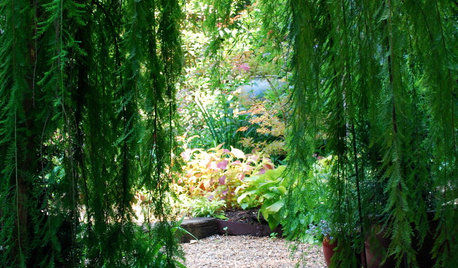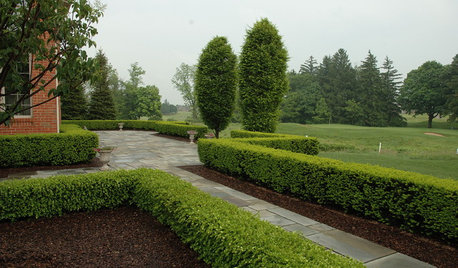Will Late Blight spores remain in your soil?
anney
14 years ago
Featured Answer
Sort by:Oldest
Comments (17)
carolyn137
14 years agocolokid
14 years agoRelated Discussions
Recommendations for ridding one's soil of blight spores
Comments (29)Here is something you might find interesting... My garden had plenty of early and late blight and septoria leaf spot. The following year I installed a hoop house over half of it and planted tomato plants inside and out (8 in/10 out). I sprayed/coated the outside plants several times (during wet periods) with a well known product used to control these diseases. The inside plants were treated only once (lower leaves only). Soil was the same inside and out (top quality and ammended-well with organic compost). The plants in the hoop made it all the way to freeze disease free! No blight at all inside. The outside plants, well, they were pretty much toast about 45 days earlier. The hoop house makes it sooooo much easier to garden. Never had to worry about pruning wet foliage (as it was often wet outside from the morning dew and rainstorms). The hoop house was not sealed off. It was about 50% open (no side or end walls). The plastic on top kept the direct rain off but there was some splashing along the sides. (I use leaf mulch to keep the soil from splashing up the stems). I can go on-an-on about the benefits of the hoop house but perhaps best is the reduction in plant disease. (but gardening during thunderstorms is pretty cool too!) My overall production was up more than 50%. And I suspect that with the dry and sunny conditions inside the hoop structure this winter (off-season), the bacteria and molds won't stand a chance (but I will still rotate anyway). One note, I trained my tomato plants to a rope attached to the top of the hoops. It grew vine-like plants vs. bushy plants you get on cages. It keeps the foliage drier and blight at bay. I am now less concerned about growing heirloom varieties. I hope I didn't get off topic....See MoreLate Blight Tomatoes Left on Field Overwinter
Comments (3)All that debris is harboring the spores for this year's disease. Should have been removed last year. Or, plowed/dug under. See http://www.ipm.ucdavis.edu/PMG/r783100211.html Here is a link that might be useful: management late blight...See MoreLate Blight on Tomatoes
Comments (4)but someone in the Tomato Forum pointed out this forum, which I didn't know about, so I'm reposting it here. ] I'm that someone. LOL Barb, Do you have any pictures and/or are you absolutely convinced that what your plants have is Late BLight ( P.infestans)? I ask only b'c Late BLight is not common in your area, as you know, Late Blight is lethal, regardless of the weather, and from the time the typical symptoms first appear the plants will be a mass of black stinking tissue within 1-2 weeks. What might be sprayed would be sprayed as a preventative, not after the fact, and products available to home growers are not very effective, to be quite honest. No, it doesn't splash up form the soil unless infected plants had been grown there in a previous season; all new infections are airborne. Has someone made a definitive diagnosis for your plants re Late Blight? If not, do you want to go thru some descriptions on your part and questions on my part? Carolyn...See MoreLate blight in May? Help!
Comments (6)Thank you! I am feeling better now. Dave, I started them from seed back in February. They are not in the ground yet. They were getting big, so I repotted them in 3 gallon pots and they moved into a hoop house waiting for some better weather. (Before, when they lived in the house, I used to take them out every morning and bring them in the house every night so they could get sunshine). Now with rain pretty much every day and not a ray of sun for a week the temps in the hoop house slowly but surely almost leveled with the outside temps. We've been having colder weather for 2 weeks and mist or rain every day for a week. The plants in the hoop house have wet leaves from condensation pretty much 24 hours. So I got a little worried. I'll post a picture when I have a bit more time (after I feed the little one) for a better diagnosis. Thank you for your help!...See Moreanney
14 years agoanney
14 years agocolokid
14 years agokorney19
14 years agocarolyn137
14 years agoUser
14 years agorobeb
14 years agocarolyn137
14 years agojtcm05
14 years agocarolyn137
14 years agocarolyn137
14 years agoanney
14 years agobig_moorlygho1
14 years agobig_moorlygho1
14 years ago
Related Stories

GRASSESHow to Rock a Lawn
Weekend Project: The key to healthy grass begins with the soil. If turf works for you, here’s how to fix it and keep it looking its best
Full Story
FARM YOUR YARDHow to Grow Vegetables in Containers
Get glorious vegetables and fruits on your patio with a pro’s guidance — including his personal recipe for potting mix
Full Story
SPRING GARDENINGSummer Crops: How to Grow Strawberries
Pluck your own sweet strawberries right from the garden vine for smoothies, salads or eating then and there
Full Story
EDIBLE GARDENSHow to Add an Apple Tree to Your Edible Garden
Readily available, beautiful and fragrant, apple trees offer four-season interest along with crisp, juicy fruit
Full Story
EDIBLE GARDENSSummer Crops: How to Grow Tomatoes
Plant tomato seedlings in spring for one of the best tastes of summer, fresh from your backyard
Full Story
MOST POPULARWhat to Do After a Hurricane or Flood
How you treat your home after a natural disaster can make all the difference in its future livability — and your own personal safety
Full Story
LANDSCAPE DESIGNTo Make Your Garden Memorable, Add a Hint of Mystery
An element of mystique — intriguing gates, an interplay of light and shadow, hidden views — can take your garden to the next level
Full Story
GARDENING GUIDESWhat Are Your Spring Gardening Plans?
Tearing out the lawn? Planting edibles? Starting from scratch? Tell us what you plan to change in your garden this year
Full Story
SPRING GARDENING7 Spectacular and Practical Spring-Flowering Trees
Put on a beauteous show in the garden with a landscape tree awash in flowers — just do your homework first
Full Story
GARDENING GUIDESGreat Design Plant: Boxwood
This elegant evergreen can shape shift into forms limited only by a gardener's imagination and a clipper's reach
Full Story


carolyn137